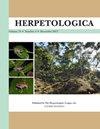Intraspecific Variation in Diet Composition and Morphology of Yucatecan Cantils (Agkistrodon russeolus Gloyd 1972 [Serpentes: Viperidae])
IF 1.1
3区 生物学
Q2 ZOOLOGY
引用次数: 0
Abstract
Abstract: Detailed studies on the natural history of snakes are essential for ecological hypothesis-driven research and effective conservation. Herein, we studied the diet composition and morphology of Yucatecan Cantils (Agkistrodon russeolus Gloyd 1972 [Serpentes: Viperidae]), an understudied viperid species endemic to the Yucatán Peninsula. We collected data from live free-ranging snakes; freshly road-killed snakes and snakes deliberately killed by local villagers; and museum specimens and literature sources. We compared their age classes, sexes, and color morphs. Data came from snakes from Yucatán, Quintana Roo, and Campeche in Mexico, and two records were from northern Belize, comprising most of the species' distribution range. Examination of 76 individuals resulted in 77 prey items from 68 snakes. Results indicated that A. russeolus is a generalist-opportunistic predator that feeds on a wide variety of vertebrates, but primarily on lizards and small mammals and less frequently on birds, snakes, and anurans. Geographic patterns in the diet and morphology of A. russeolus were evident: snakes from the coastal region were smaller in body size and less heavy bodied and with a heavily lizard-based diet, whereas snakes from both dry and moist forest regions were larger and heavier and their diet was primarily mammal based. We did not detect differences in diet composition among age classes because lizards and mammals were eaten at all stages of life, but an “ontogenetic telescope” was evident; that is, the importance of mammals increases with snake body size and the spectrum of prey types consumed also broadens. Males had longer tails than females, and females were light colored more often than males, but other morphological characteristics were similar between the sexes. The sexes and color morphs did not differ in diet composition. We did not detect dietary composition variations between seasons, and our data indicate that this species can feed year-round opportunistically. Because of increasing environmental pressures within its range, studies are urgently needed to elucidate other critical aspects of the ecology of this viperid species.尤卡坦悬臂鱼(Agkistrodon russeolus Gloyd 1972)食性组成和形态的种内变异[蛇目:蝰蛇科]
摘要:对蛇的自然历史进行详细的研究对于生态学假设驱动的研究和有效的保护至关重要。在此,我们研究了尤卡坦半岛特有的一种研究不足的毒蛇,尤卡坦Cantils(Agkistrodon russelus Gloyd 1972[蛇:毒蛇科])的饮食组成和形态。我们收集了自由放养的活蛇的数据;刚在公路上杀死的蛇和当地村民故意杀死的蛇;以及博物馆标本和文献来源。我们比较了他们的年龄、性别和肤色。数据来自墨西哥尤卡坦、金塔纳罗奥和坎佩切的蛇,两项记录来自伯利兹北部,构成了该物种的大部分分布范围。对76条个体进行了检查,从68条蛇中提取了77个猎物。结果表明,赤藓是一种广泛的机会主义捕食者,以各种脊椎动物为食,但主要以蜥蜴和小型哺乳动物为食,较少以鸟类、蛇和无尾类动物为食。赤尾蛇的饮食和形态的地理模式很明显:沿海地区的蛇体型较小,体重较轻,以蜥蜴为食,而干旱和潮湿森林地区的蛇体积较大,体重较重,主要以哺乳动物为食。我们没有发现不同年龄段的饮食组成存在差异,因为蜥蜴和哺乳动物在生命的各个阶段都被吃掉,但“个体遗传学望远镜”是显而易见的;也就是说,哺乳动物的重要性随着蛇的体型而增加,猎物种类的范围也随之扩大。雄性比雌性有更长的尾巴,雌性比雄性更常是浅色的,但其他形态特征在性别之间是相似的。性别和颜色在饮食组成上没有差异。我们没有发现季节之间的饮食成分变化,我们的数据表明,该物种可以全年机会主义地进食。由于其范围内的环境压力越来越大,迫切需要进行研究来阐明这种蝰蛇物种生态学的其他关键方面。
本文章由计算机程序翻译,如有差异,请以英文原文为准。
求助全文
约1分钟内获得全文
求助全文
来源期刊

Herpetologica
生物-动物学
CiteScore
4.60
自引率
0.00%
发文量
27
审稿时长
>12 weeks
期刊介绍:
Established in 1936, Herpetologica is a quarterly peer-reviewed journal serving herpetologists, biologists, ecologists, conservationists, researchers and the scientific community. The journal contains original research papers and essays about the biology of reptiles and amphibians, and covers many relevant topics including: behavior, conservation, ecology, genetics, morphology, physiology and taxonomy.
 求助内容:
求助内容: 应助结果提醒方式:
应助结果提醒方式:


